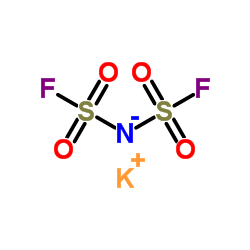Potassium bis(fluorosulfonyl)imide
Modify Date: 2025-08-25 00:15:53

Potassium bis(fluorosulfonyl)imide structure
|
Common Name | Potassium bis(fluorosulfonyl)imide | ||
|---|---|---|---|---|
| CAS Number | 14984-76-0 | Molecular Weight | 219.229 | |
| Density | N/A | Boiling Point | N/A | |
| Molecular Formula | F2KNO4S2 | Melting Point | 102 ºC | |
| MSDS | N/A | Flash Point | N/A | |
| Name | Potassium bis(fluorosulfonyl)azanide |
|---|---|
| Synonym | More Synonyms |
| Melting Point | 102 ºC |
|---|---|
| Molecular Formula | F2KNO4S2 |
| Molecular Weight | 219.229 |
| Exact Mass | 218.887390 |
| PSA | 85.04000 |
| LogP | 1.95030 |
| InChIKey | MHEBVKPOSBNNAC-UHFFFAOYSA-N |
| SMILES | O=S(=O)(F)[N-]S(=O)(=O)F.[K+] |
|
Section 1: Product Identification Chemical Name:Potassium bis(fluorosulfonyl)imide, 99.5+% CAS Registry Number:14984-76-0 Formula:K[N(SO2F)2] EINECS Number:none Chemical Family:metal imide compound Synonym:none
Section 2: Composition and Information on Ingredients IngredientCAS NumberPercentACGIH (TWA)OSHA (PEL) Title compound14984-76-0100%2.5mg/m3 (as F)2.5mg/m3 (as F) Section 3: Hazards Identification Emergency Overview:Irritating to skin, eyes and respiratory tract. May be harmful if swallowed. Primary Routes of Exposure:Ingestion, inhalation Eye Contact:Causes slight to mild irritation of the eyes. Skin Contact:Causes slight to mild irritation of the skin. Inhalation:Irritating to the nose, mucous membranes and respiratory tract. Ingestion:No information available on the physiological effects of ingestion. May be harmful if swallowed. Acute Health Affects:Irritating to skin, eyes and respiratory tract. No information on long-term chronic effects. Product contains fluorine which, under certain conditions of use, Chronic Health Affects:decomposition or metabolism, may generate fluoride ion causing nausea, vomiting, labored breathing, hypocalcaemia, deterioration of bone and tooth structure and kidney and liver damage. NTP:No IARC:No OSHA:No SECTION 4: First Aid Measures Immediately flush the eyes with copious amounts of water for at least 10-15 minutes. A victim may need Eye Exposure: assistance in keeping their eye lids open. Get immediate medical attention. Wash the affected area with water. Remove contaminated clothes if necessary. Seek medical assistance if Skin Exposure: irritation persists. Remove the victim to fresh air. Closely monitor the victim for signs of respiratory problems, such as difficulty Inhalation: in breathing, coughing, wheezing, or pain. In such cases seek immediate medical assistance. Seek medical attention immediately. Keep the victim calm. Give the victim water (only if conscious). Induce Ingestion: vomiting only if directed by medical personnel. SECTION 5: Fire Fighting Measures Flash Point:no data Autoignition Temperature:no data Explosion Limits:no data Extinguishing Medium:carbon dioxide, dry powder or foam If this product is involved in a fire, fire fighters should be equipped with a NIOSH approved positive pressure Special Fire Fighting Procedures: self-contained breathing apparatus and full protective clothing. Hazardous Combustion andIf involved in a fire this material may emit irritating fumes. Decomposion Products: Unusual Fire or Explosion Hazards: No unusual fire or explosion hazards. SECTION 6: Accidental Release Measures Small spills can be mixed with vermiculite, sodium carbonate or other suitable non-combustible adsorbent and Spill and Leak Procedures: swept up. SECTION 7: Handling and Storage Store in a tightly sealed container under an inert atmosphere of nitrogen or argon. Keep in a cool, dry, Handling and Storage: well-ventilated place. SECTION 8: Exposure Controls and Personal Protection Eye Protection:Always wear approved safety glasses when handling a chemical substance in the laboratory. Skin Protection:Wear protective clothing and gloves. Ventilation:Handle the material in an efficient fume hood. If ventilation is not available a respirator should be worn. The use of respirators requires a Respirator Respirator: Protection Program to be in compliance with 29 CFR 1910.134. Ventilation:Handle the material in an efficient fume hood. Additional Protection:No additional protection required. SECTION 9: Physical and Chemical Properties Color and Form:white pwdr Molecular Weight:219.23 Melting Point:no data Boiling Point:no data Vapor Pressure:no data Specific Gravity:no data Odor:none Solubility in Water:insoluble SECTION 10: Stability and Reactivity Stability:moisture sensitive Hazardous Polymerization:no hazardous polymerization Conditions to Avoid:prolonged exposure to moisture Incompatibility:oxidizing agents and active metals Decomposition Products:carbon monoxide, carbon dioxide, sulfur dioxide, fluorinated by-products and organic fumes. SECTION 11: Toxicological Information RTECS Data:No information available in the RTECS files. Carcinogenic Effects:no data Mutagenic Effects:no data Tetratogenic Effects:no data SECTION 12: Ecological Information Ecological Information:No information available SECTION 13: Disposal Considerations Disposal:Dispose of according to local, state and federal regulations. SECTION 14: Transportation Shipping Name (CFR):Non-hazardous Hazard Class (CFR):NA Additional Hazard Class (CFR):NA Packaging Group (CFR):NA UN ID Number (CFR):NA Shipping Name (IATA):Non-hazardous Hazard Class (IATA):NA Additional Hazard Class (IATA):NA Packaging Group (IATA):NA UN ID Number (IATA):NA SECTION 15: Regulatory Information TSCA:Not listed in the TSCA inventory SARA (Title 313):Not reportable under SARA 313 Second Ingredient:none SECTION 16 - ADDITIONAL INFORMATION N/A |
| Hazard Codes | Xi |
|---|
| Potassium bis(fluorosulfonyl)azanide |

